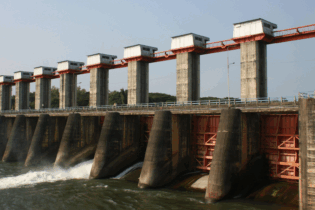Consultants Royal HaskoningDHV has completed a 21 month feasibility study for Biodiversity Protection of the Magaliesberg Mountain. The findings can complement the Government’s application to UNESCO to declare the mountain range an official Biosphere.
The study which began in July 2012 was undertaken for the City of Tshwane and South African Biodiversity Institute (SANBI) and as lead consultants, Royal HaskoningDHV were supported by David Hoare (grassland ecologist) and Siegwalt Küsel (Landscape Architect). The consultants have successfully completed previous studies either directly for these entities or with others, which established their level of skill and expertise. These have included SANBI’s Grasslands Programme, Development of a Green Servitudes Tool and a Biodiversity Strategy and Action Plan for the City of Johannesburg. Context of the study Environmental and climate change specialist and project manager for the feasibility study, Gerard van Weele strategic environmental planner at Royal HaskoningDHV, explained the context of the assignment. “The Gauteng Conservation Plan (C-Plan) and National Protected Areas Expansion Strategy (NPEAS) both identify the Magaliesberg Mountain Range as a natural feature with high biodiversity value. Further to this, it is suggested that the region be earmarked for expansion of protected area estates in Gauteng and North West provinces. In addition, the region contains areas of cultural significance (for example initiation sites) which need to be maintained.” “Unfortunately, the section of the Magaliesberg adjacent to the townships of Mamelodi in the east of the City of Tshwane is characterised with socio-economic and development pressures which place strain on the natural resources and is leading to degradation of the biodiversity and conservation values. Mamelodi East hosts a great number of informal settlements and limited infrastructure. This region is encroaching on the East-West lying escarpment of the Magaliesberg Mountain Range, immediately to the North of Mamelodi. In addition, the western section of Mamelodi borders Eersterust to the west and the industrialised area of Silverton to the south-west. The current land uses associated with these areas place direct pressure on natural areas. To the north, the rapidly developing semi-urban areas of Derdepoort, Baviaanspoort and areas surrounding Roodeplaat Dam continue to encroach onto the Magaliesberg in part due poor land use management. Responsibility for management of the area was previously split between the Nokeng Tsa Taemane Local Authority (within Metsweding District Municipality) and City of Tshwane Metropolitan Municipality, which contributed to the problems. Going forward, a balance needs to be found between the protection of biodiversity, recreational access, private and public development and socio-economic upliftment for the current residential areas in the region. This will require a full understanding of the ecological status as well as the social dynamics of the area. Only then can a sustainable development plan be formed that takes into consideration all the requirements of the land. The overall aim of the project was to assist the City of Tshwane with the need to …“understand the different and sometimes conflicting interests in the area while trying to come to grips with the problems which threatens the conservation of this part of the Magaliesberg. The City aims to find workable solutions for a harmonious and sustainable relationship between the mountain and the people using it…”.Positive outcomes
“The project site includes everything from recreational areas, cultural sites, threatened ecosystems and a perennial river cutting through a 2300 million years old geological feature” says van Weele. Surprisingly, the feasibility assessment shows that the level of encroachment has not yet passed a threshold where a downwards spiral is inevitable. The study identified an opportunity where the natural richness could be sustained for the benefit of the surrounding communities. A careful evaluation of interests and activities led to a proposal for land use management on the ridge that with careful administration and the right type of leadership from the authorities can integrate formal protected areas with communal areas and create opportunities for benefits sharing by the surrounding suburbs. Challenges and actions The project site is notorious for criminal activities, and visits to the area take place under armed guards. Some vestige of traditional leadership remains in the urban context, and therefore the study had to ensure community buy-in through targeted consultation. Recommendations are that The City of Tshwane needs to intervene in this section of the Magaliesberg to ensure protection of sensitive biodiversity, but also to create a well-managed resource that the public can access safely for recreation and interaction with nature. A UNESCO recognised Biosphere? The Magaliesberg Mountain range was proposed as a protected area as far back as 1977, and formally proclaimed as the Magaliesberg Protected Natural Environment (MPNE) in 1994. In 2006 the concept of including the MPNE into a broader Magaliesberg Biosphere was proposed by the Magaliesberg Protection Association to ensure that the sensitive areas are protected and that the valuable assets of the wider areas are utilised in a sustainable and responsible manner. The proposal is centred on the existing MPNE which, unfortunately, does not include the Mamelodi section. The term ‘Biosphere’ is used to describe areas of conservation value where a group of landowners, such as farmers, provincial authorities or the state have combined forces to have an area declared a conservancy, a natural protected area or an area of unique ecological value, and an official ‘Biosphere’ would be one recognised under the auspices of the UNESCO Man and Biosphere project. The initial application was submitted in 2012 but due to issues relation to the incomplete zoning, insufficient public participation and the inclusion of Pelindaba, this application was deferred. This allowed the South African government to update the application and include all the changes that was requested by the Council in order to depict the complete biosphere and to exclude Pelindaba. The updated application was submitted to UNESCO in October 2013 and a decision is expected in June 2014.






